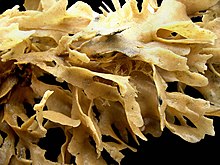
Summary
Flustrina is a suborder under the order Cheilostomatida of gymnolaematan Bryozoa (sea mats).
| Flustrina Temporal range:
| |
|---|---|

| |
| Colony of Flustra foliacea (Flustridae) | |
| Scientific classification | |
| Domain: | Eukaryota |
| Kingdom: | Animalia |
| Phylum: | Bryozoa |
| Class: | Gymnolaemata |
| Order: | Cheilostomatida |
| Suborder: | Flustrina Smitt, 1868 |
| Synonyms | |
|
Cellulariomorpha | |
The structure of the individual zooids is generally simple, a box-like chamber of calcium carbonate, the polypides reaching out through an uncalcified flexible frontal wall, often surrounded by numerous spines. Like in other gymnolaematans, their lophophore is protruded by muscles that pull on the frontal wall of the zooid.
In some treatments, the Flustrina are restricted to the superfamilies Calloporoidea and Flustroidea and ranked as infraorder alongside the Cellulariomorpha which contain the other three superfamilies. What here is considered the Fulstrina is then called the infraorder Neocheilostomina, and in a more radical variant also includes the Ascophora as another infraorder.[1]
The obsolete suborder Anasca previously included the members of this suborder before being deprecated.[2]
The families Fusicellariidae, Skyloniidae, Bicorniferidae, as well as the genera Hoeverella and Taeniocellaria are currently incertae sedis within the Flustrina.
Systematics edit
The superfamilies and families (and notable genera) are listed in the presumed phylogenetic sequence:[3]
|
|
See also edit
References edit


